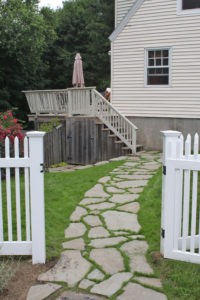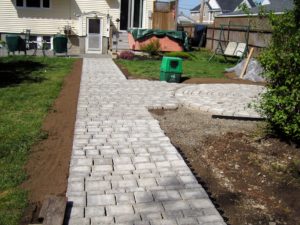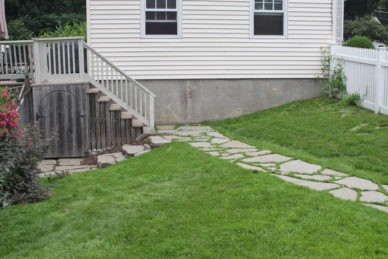Don’t trample over that meticulously maintained lawn every time you need to go from the house to the gardens. A garden pathway offers the perfect solution to preserve your lush grass and enhance the beauty of your backyard.
Garden paths serve a dual purpose: they keep your plants safe from accidental trampling while adding a cohesive and professional touch to your landscape. When done correctly, these paths can even accentuate specific plants along their course.
With such a wide variety of garden paths available, it’s natural to feel overwhelmed when deciding which type is best for your yard. Garden paths come in diverse shapes and sizes, so it’s essential to determine your desired path style before selecting the materials.
In the following article from gardeningtipsandideas.com, you’ll discover insights into different types of garden paths and how they can elevate the overall harmony and aesthetics of your garden.
11 Garden Paths and Pathway Ideas
Unless you garden indoors, or on a balcony, or on a tiny crevice somewhere in the abandoned outback, moving around your garden can only be facilitated by some form of pathway. Garden paths are the route we take to get from point A to point B and give us access to to our garden beds and other features and resources that reside in our yards. While paths serve a practical purpose they also add aesthetic appeal to our gardens. The veins of our garden architecture can be so much more than mere accessways. In fact, many gardens are highlighted by their paths that accentuate the plantings and other features. The real beauty of pathways is that there are no rules. Garden paths can be constructed from almost any material and can be installed within a few hours, a weekend or, for those very intricate and detailed jobs, many months.
Stepping-Stones

Flagging stone
-
Large Blocks
Carved and shaped blocks lie in this pond seemingly floating above an eternal void. This type of path is not something to try if you have a few hours to pass. The sheer size of the blocks, even if they are already cut, will take more than one person to maneuver.
-
Floating Steps
However, a stepping-stone path like this could easily be constructed within a weekend. Brick piers rising out of the watercourse are topped with a pebbled slab. The only precaution with this style is ensuring that the slab is fastened securely and maintained over time. While this style of path looks quite intriguing they can become very dangerous over time and vigilance will need to keep them maintained.
-
Pre-Fab Stepping Rounds
If you’re after a less intensive stepping-stone path then buying pre-fabricated rounds, squares or any shape and then surrounding with pebbles is a great option. Log rounds, sliced across the grain of a hardwood tree, work really well too but be prepared to replace these within 5-10 years as rot and nature take their course. If you’re going to use logs then check for white-ant infestations before you add them to your garden.
Inset Paths
While stepping-stone paths are usually based on a stepping platform raised above ground level, insets are paths that are set at ground-level or below. They are created to seamlessly mesh into the environment in which they will reside.
-
Lawn Insets
One of the most common form of inset paths is laying the step directly into lawn. It’s a very easy path to make and one that can really standout aesthetically. The downside, of course, is the level of maintenance needed to keep these looking great. The edges will need to be regularly trimmed and in the warmer months this may need to be a weekly chore. One other maintenance issue for this type of path is that the lawn will, over time, grow above the inset steps. Therefore, within a few years you may need to lift each step and re-align it with the level of the lawn.
-
Garden Bed Insets
Another option is to inset this path directly into the garden bed. This pathway could be constructed using wooden blocks, flagstones or any other flat material that isn’t unnatural in its shape. As a base isn’t constructed to hold these insets in place they need to be heavy and broad enough to handle the weight of those traversing it. Insets that wobble or can easily be displaced can become hazards later on.
Pebbled Paths
Some of the easiest paths to create and maintain are ones that are created with pebbles or stones. Gravel, aggregate, river stones, crushed bricks and crushed limestone – there are many more – are great options for weaving a pathway through your garden.
-
Loose Pebbles and Stones
This is a great example of an easy path solution. While loose pebbled paths require some barrier or border, once this has been completed then shoveling loads of pebbles is a very quick task. And, it’s a garden path that can easily be completed within a few hours – depending on it’s length – or at least within a weekend. The benefit is once it’s down there shouldn’t be too many ongoing maintenance issues, either.
-
Fixed Pebbles and Stones
If you have enough time, and plenty of patience, then challenging yourself to create a fixed pebble or stone path is certainly rewarding – when it’s finished! But don’t expect that to be anytime soon as these paths need to be done in stages and can take weeks, months or years. The base of the path is usually concrete but could also be cemented limestone. As the slurry begins to set, pebbles or stones are set in decorative arrays and held fast over the years.
Paved Pathways
Paved paths can be traced back as far as the Romans as their roads were all built with paved clay-fired bricks. And there’s no prizes for guessing what they perceived as the benefits such construction. Strength, endurance and the durability to weather the elements were all positives for this type of pathway.

Brick Walkway
-
Brick-paved Paths
They are easy to lay, will last a long time and are strong enough to withstand most climates. Depending on the pattern selected – herringbone, brick-pattern, basket weave, stretcher-bond etc (here’s a link for more patterns)- will determine the amount of time it takes to construct such a path. However, regardless of the style, most of the work goes into preparing a base for the bricks to sit on. If you get this right then your paved path should outlast you, but skimp on the effort at this level and you could be repairing dips, raised bricks or ones that are falling away for the rest of your life.
-
Tile-paved Paths
While you may expect that tiles are an indoor medium, they are starting to become popular outdoors as well. There are three ways to do these; the first is similar to the Fixed Pebble path in that they are inset into concrete (usually colored). The second is like brick paving where terracotta tiles are laid on a gravel/sand base while the final option is to fasten them onto a concrete path with some form of adhesive. The third choice is great if you’re wanting to give your garden a new look to an old path. Instead of removing that ghastly 1950′s concrete path, provided it is still structurally sound, you could easily give it a face-lift with some mosaics or tessellated patterns.
Vertically-Defined Paths
Pathways don’t have to be constructed on the horizontal plane all the time. While we usually consider a pathway to exist by the material that we’re walking on, we can also consider a path when it is created by borders or via the vertical plane.
-
Formally-Defined Vertical Paths
The classic example of this style of path is where garden beds are raised or bordered. This intuitively creates a pathway for people to meander, and work, in your garden. No material is used on the base of the path, it just evolves because of the bordering barriers. It’s an easy form of path if you’re already constructing the barrier but can be quite time-consuming if the border has no other purpose than to define the pathway. That being stated, it must also be observed that temporary barriers in a garden can very easily be erected and divert traffic effectively away from areas that aren’t open to the public.
-
Informally-Defined Vertical Paths
The best example of an informally-defined vertical path are the ones we find in forests and within natural areas. The forest path is usually created either by people trekking through a particular pathway or by water-runoff carving into the side of the landscape. Obviously, to create a path like this in your own garden requires a substantial portion of land yet while it appears to be informal can easily be manipulated to work in your own yard.
While this list doesn’t cover all the possible pathway options, it serves as a starting point to spark your creativity and explore various resources and mediums for garden paths. Garden pathways are more than mere access routes to your yard; they can be artistic landscaping features that elevate your garden’s charm.
Whether you prefer stepping stones, inset paths, pebbled walkways, paved trails, or vertically-defined routes, garden paths have the power to enhance the aesthetic appeal of your garden.
Once you’ve decided on the types of garden paths that best suit your landscape, Camosse Masonry Supply can assist you in selecting the necessary materials for your project. We offer a wide range of materials for garden paths. Feel free to reach out to us for more details about our products designed to enhance your garden paths.
Your friends will undoubtedly be impressed when they stroll through your landscaped haven, appreciating the ease and beauty of your well-crafted garden paths.

